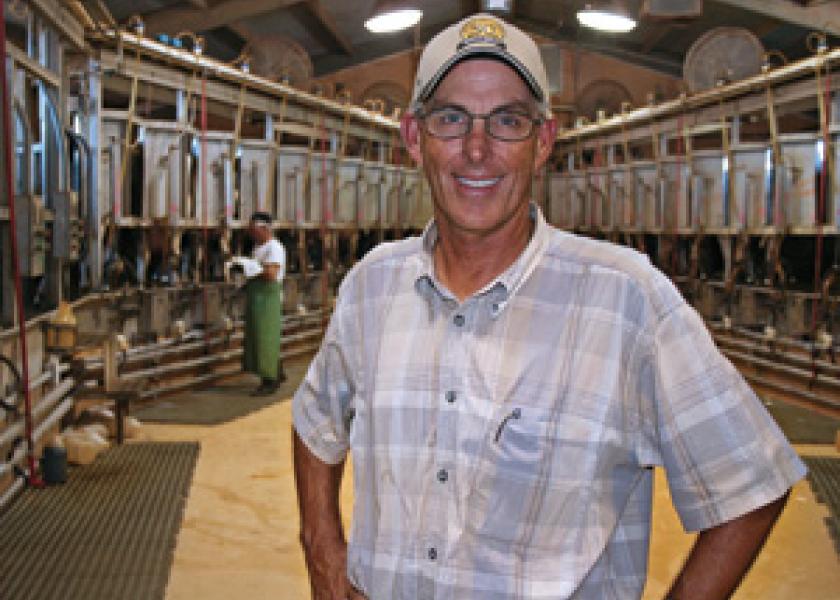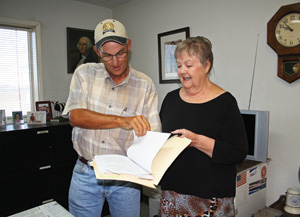'I Survived an I-9 Audit'

An Arizona dairy learns firsthand about ‘silent raids’
"ICE just showed up."
Arizona dairy producer Ross Tappan was attending a United Dairymen of Arizona meeting in Tempe last April when that text message from his office manager appeared on his mobile phone.
Tappan didn’t panic. He finished the meeting and then drove to his 6,300-cow dairy near Mesa, 25 miles away.
By the time he arrived, the two U.S. Immigration and Customs Enforcement agents—whose visit had lasted just five minutes—were gone. But their directive had been clear: They would return in 72 hours to collect three years’ worth of I-9 forms and other employee documents from the dairy.
That day marked the beginning of a month-long ordeal that eventually cost Tappan 10 of his dairy’s 90 employees—more than 10% of his work force.
Bonus Content |
But Tappan believes he was lucky—in a way. The ICE agents didn’t conduct the kind of raid that routs and removes workers on the spot, leaving a dairy with no one to milk or feed its cows. Moreover, as an employer in a state that’s taken a hard-line stance against illegal immigration, Tappan was already one step ahead.
"We’d been preparing for an I-9 audit for three years," he says. "We kind of expected it."
An I-9 audit, often called a "silent raid," involves a thorough ICE inspection of a business’s employee documents, principally I-9 forms and payroll information. The goal is to ensure that employees are legally authorized to work in the U.S.
To meet this goal, the government launched an electronic employee verification program in 1997. It was expanded to all states and the District of Columbia in 2004, and is now called E-Verify. Operated by the U.S. Department of Homeland Security (DHS) and the Social Security Administration, E-Verify is an Internet-based system that checks Social Security numbers to verify whether a person can legally work in the U.S.
Nationwide, more than 269,000 employers at more than 900,000 work sites are enrolled in the E-Verify program, DHS says.
While E-Verify isn’t federally mandated, a handful of states, including Arizona, require its use. At Tappan’s dairy, that was enough to spur office manager Elaine Lynch into action three years ago.
"She was adamant that we implement E-Verify," recalls Tappan, general manager of Arizona Dairy Co. "With hindsight, I’m glad we did."
Working with an immigration attorney, Tappan and Lynch conducted a self-audit before implementing E-Verify in 2008. The dairy’s inspection revealed dozens of employees with improper documentation. Tappan was forced to lay off several who couldn’t substantiate their work eligibility. The internal review reassured him that his dairy had verified its work force and that his office staff had learned how to react if ICE agents ever appeared at the dairy.
 |
| Elaine Lynch, right, was adamant that Arizona Dairy Co. implement E-Verify three years ago. "With hindsight, I’m glad we did," says Ross Tappan, left. PHOTO: Catherine Merlo |
After the ICE visit last April, Tappan and his staff went to work pulling more than 200 I-9 forms that the dairy had on file from the past three years. Much of their time was spent copying those originals as well as other requested documents, including payroll information, business licenses and paperwork on employees who were no longer employed.
"There was a funeral the following day that almost all the people on the dairy would be attending," Tappan recalls. "So we spent all night working on the I-9s. It was stressful."
As promised, the ICE agents came back three days later and collected the dairy’s I-9 forms and other documents. Twenty-five days later, the federal agency completed its audit.
It found that 11 of Tappan’s 90 employees did not have legal authorization to work in the U.S. They would have to be fired within 10 days. Half were new hires from the previous three years.
Tappan’s greatest loss was an 11-year employee whose technical and electrical skills had helped boost him to second in command under an overall manager. Others who’d failed ICE’s scrutiny ran feed mixers or worked in the calf operation.
"Six were key people we’ll really miss," Tappan says. "They had never been in trouble with the law. They were family men. They had kids in school here. Their kids played with mine."
One employee later was cleared after the audit mistakenly listed him as undocumented.
Several employees asked Tappan what they could do to legally stay. He advised them to get an immigration lawyer and cautioned that they could be picked up by law enforcement officers. He promised to rehire them if they could produce legal documentation.
"We had some workers living on housing here on the dairy," Tappan says. "I gave them a generous amount of time to leave. I wasn’t going to put anyone out on the street."
Tappan never learned why his dairy was targeted for an I-9 raid. Arizona Dairy Co. was one of 2,393 U.S. businesses that underwent I-9 audits by ICE between Jan. 1 and Aug. 6 of this year, according to Vincent Picard, ICE public affairs officer. That compares to 2,196 audits in 2010 and 1,444 in 2009. It’s not known how many dairies are among those, since ICE doesn’t track audits by industry type. But agricultural sources and news stories indicate that the number of dairy audits is growing.
"I’ve heard that ICE sometimes get calls from disgruntled workers," Tappan says. "We don’t know if we had missed filling out something on our forms. ICE didn’t tell us. I assume they didn’t want to share their trade secrets."
Tappan’s work force is clean now, he says. Most are older employees who gained legal status as a result of the Immigration Reform and Control Act of 1986, which granted amnesty to illegal immigrants who entered the U.S. before Jan. 1, 1982.
Tappan believes that if he had not been using E-Verify, he would have lost many more employees. "It would have been devastating," he says.
While he doesn’t fault ICE for doing its job, the I-9 audit has left Tappan shaking his head at the work force dilemma many dairies face.
The agricultural industry is full of immigrants who are here illegally, he acknowledges. They apply for work, and dairies need the labor. But few employers are experts at detecting document fraud.
"Arizona’s dairy industry will lose a lot of employees if every dairy uses E-Verify," Tappan says. "Dairies may have to downsize or get employees from their neighbors. It’s not like there’s a long line of U.S. citizens waiting to take dairy jobs."
Industry organizations such as United Dairymen of Arizona and National Milk Producers Federation are looking at ways to allow more immigrants to work legally in the U.S. "But it’s a long, difficult process," Tappan says.
For other dairies facing an ICE visit or audit, Tappan and Lynch have this advice:
- Be as cooperative as possible. "The ICE agents at our dairy handled us very nicely, but I think that’s because of the way we responded to them," Tappan says. "We were very approachable."
- Use E-Verify. But first do an internal audit with the help of a specialist, such as an immigration attorney. That preparation can ensure your dairy survives a genuine I-9 audit without the painful consequences of fired workers, monetary fines and even jail time. "The key is to get started now, because immigration is not going to get easier," Tappan says.
- Learn how to fill out an I-9 form properly. "Be sure you use the most current I-9 form," Lynch says. "You can go online to learn how." (Follow the Dot on page 6 to view online bonus content.) She also recommends employers compare and match signatures, height, weight and age between the two forms of identification that employees must submit.
Dairy’s New Normal
 |
| Join us for the Elite Producer Business Conference, Nov. 7–9 at the Bellagio in Las Vegas. |
Bonus Content:Register now for the Elite Producer Business Conference. |
The 2011 Elite Producer Business Conference (EPBC), celebrating the event’s 10th anniversary, will feature Arizona dairy producer Ross Tappan and ag immigration attorney Anthony Raimondo during its first full day of programming.
Both men will describe what it’s like to go through an Immigration and Customs Enforcement audit of employee documents and will offer tips on how to prepare your dairy for such an audit.
The conference theme, "Dairy’s New Normal: Volatility, Opportunity, Risk and Reward," highlights the new challenges and risks of the U.S. dairy industry’s move onto the world stage as a major exporter. The 2011 EPBC opens Monday, Nov. 7, and runs through noon on Wednesday, Nov. 9, at the Bellagio in Las Vegas.
The EPBC will once again open with Michael Swanson, vice president and chief economist of Wells Fargo. Swanson will zero in on the global economic trends that will shape the dairy industry during the next decade.
A panel of dairy risk managers, traders and brokers will discuss how to cope with increased price risk for both milk and inputs and how to position your dairy to grab opportunities when they arise.
One of the highlights of the conference will be a special presentation by Patrick Doyle, president and CEO of Domino’s Pizza. He and Tom Gallagher, president and CEO of Dairy Management Inc., will describe how the dairy checkoff’s partnership with Domino’s has opened up a whole new approach to pizza sales.
Dairy Today’s own Dollars and Sense producer panel will kick off the Wednesday morning program. These four producers, from Arizona, Minnesota, Pennsylvania and Washington, will detail how they manage risk and cope with volatile markets on their dairies, which range in size from 670 to 3,200 cows.
New this year are break-out sessions that will allow attendees to choose among presentations on generational transfer of farm ownership, handling inspections and raids, and mobile technology apps for the farm.







